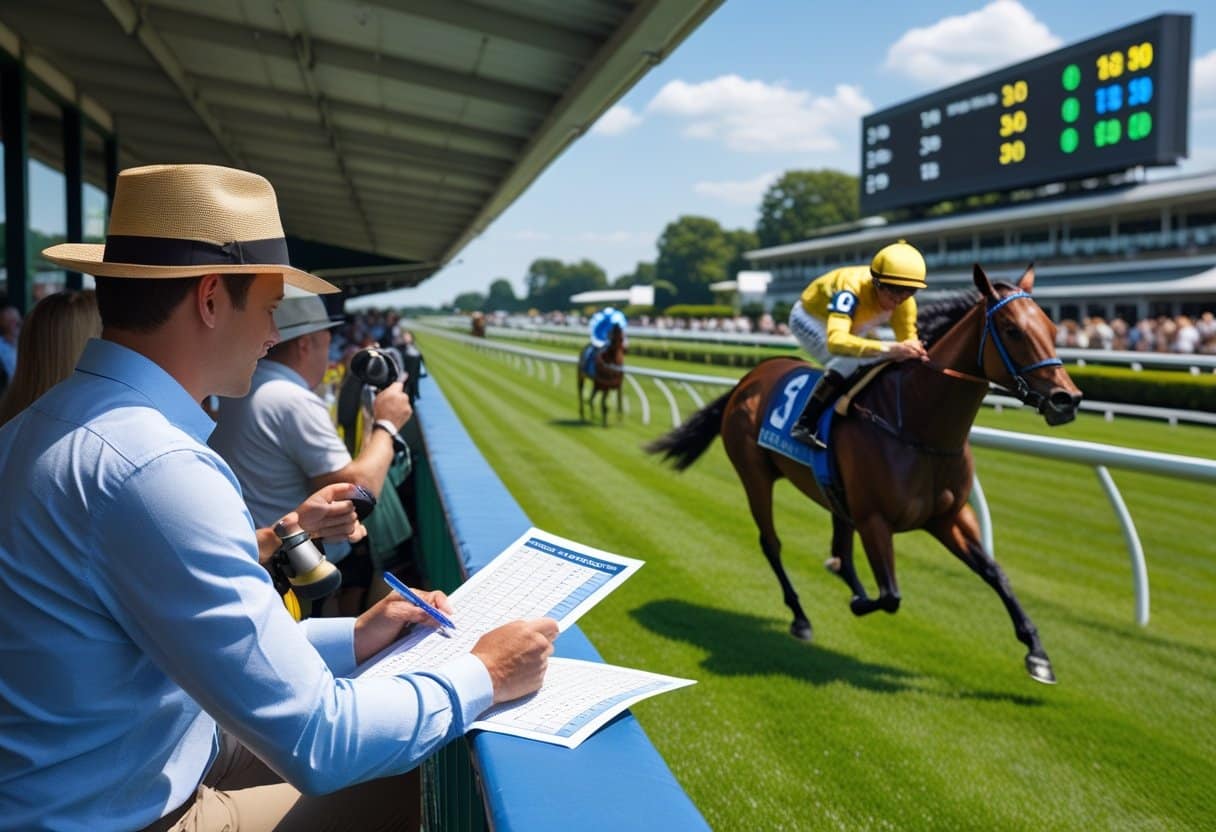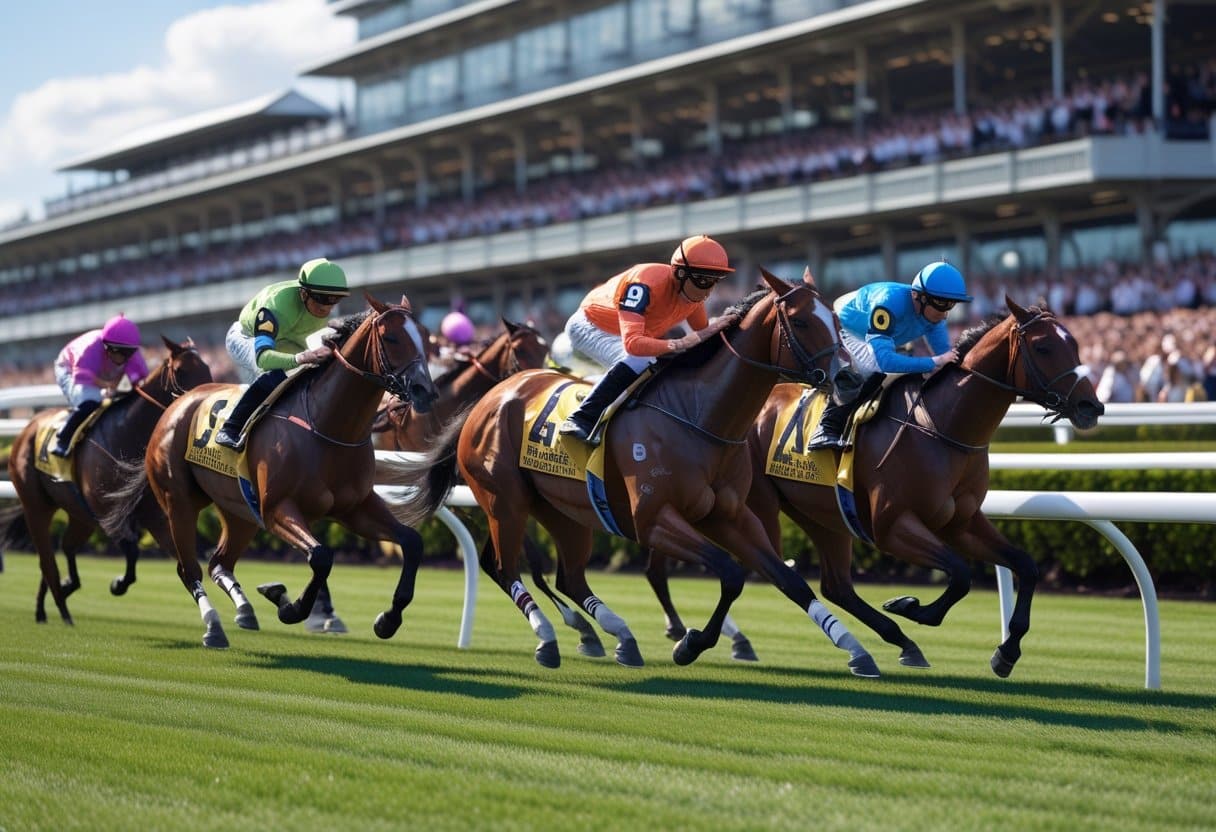Summer’s here, and the horse racing season is firing on all cylinders. As we slide into the thick of the racing calendar, a bunch of big stakes races are about to unfold.
These top-tier events bring out the best horses, all gunning for hefty purses—especially in those Grade 1, 2, and 3 contests.

The real trick to successful horse racing betting? It’s all about weighing potential payoffs against the actual odds of winning. This value-based approach helps you spot those moments when the odds pay more than the risk really deserves.
If you want to make the most of your summer betting, dialing in the right strategies can make things a lot more consistent—even if there’s no magic formula.
Different races call for different tactics. Sprints? You’ll want to watch horses that get out of the gate fast.
Longer races? Stamina and smart positioning matter way more.
It pays to study track conditions and keep an eye on jockey stats. That little bit of extra homework can give you a real edge as you place your summer wagers.
Understanding Summer Horse Racing Stakes

Summer horse racing is packed with stakes races that draw top-level thoroughbreds and jockeys, all chasing big purses.
These events are loaded with betting opportunities and tend to have strict qualification rules or unique racing conditions that can really shake up the results.
Major Races and Key Dates
The Summer Stakes is a highlight, especially since it’s part of the Breeders’ Cup Challenger Series. Win it, and you’re straight into the Breeders’ Cup Juvenile Turf.
The Triple Crown wraps up in early summer with the Belmont Stakes, usually in June and carrying a $1.5 million purse.
After that, the summer calendar fills up with plenty of other big-name stakes races.
Stakes races cost owners nomination and entry fees, which is why the prize money is so much higher than your average race.
Purses can run from a few hundred thousand up to millions.
If you’re betting, keeping a close eye on the stakes schedule is a must. Summer’s loaded with graded stakes (Grade I, II, and III) that bring in the sport’s best and offer some seriously juicy betting chances.
Significance of Track and Weather Conditions
Summer racing isn’t just about the heat—it’s about how tracks and horses respond to all sorts of weather.
Dirt tracks can get faster and harder when it’s hot and dry. Turf courses might be firm or soft, depending on how much they’re watered. Synthetic surfaces stay pretty consistent, but extreme heat can still make things weird.
Humidity and temperature play a big role, too. Some horses seem to thrive when it’s blazing hot, while others just wilt.
It’s worth checking a horse’s past performances in similar weather before you bet. A horse that loves firm summer turf might flounder if a storm rolls in and the ground turns to mush.
Impact of Post Position in Summer Events
Where a horse starts on the track—the post position—can make a bigger difference than you might think, especially on tracks with sharp turns or short straightaways.
Inside posts (1-3) save ground but can box a horse in, while outside posts offer more room but force horses to travel farther.
Post Position Considerations:
- In sprints, outside posts can help horses avoid getting stuck in traffic.
- For longer races, inside posts are usually better for saving ground.
- Some tracks just seem to favor certain positions, so it pays to know the local quirks.
The shape of the track matters, too. Belmont Park, for example, has wide turns and a long stretch—totally different from some of the tighter summer tracks.
Post position stats can vary a lot from one track to another, so don’t just assume what works at one place will work everywhere.
Types of Bets in Summer Horse Racing
Summer racing brings a whole menu of betting options—and knowing how they work is half the battle.
Standard Bets: Win, Place, and Show
If you’re just getting started, standard bets are the way to go.
A Win bet pays only if your horse comes in first. It’s riskier, but the payout’s better.
A Place bet gives you a cushion—your horse just has to finish first or second. The payout drops, but your odds of cashing in go up.
A Show bet is the safest: you get paid if your horse finishes anywhere in the top three. The returns are smaller, but you’ve got the best shot at winning something.
Can’t decide? An Across-the-board bet covers all three—win, place, and show—on the same horse.
Exotic Wagers: Exacta, Trifecta, and Superfecta
Exotic bets are more challenging, but the rewards can be massive.
An Exacta means picking the first and second horses in order. If you want a little wiggle room, you can “box” your picks, so they can finish in either order.
Trifecta steps it up: you need to call the first, second, and third horses, in exact order. Nail it, and the payouts are usually pretty sweet, especially with big fields.
Then there’s the Superfecta—predict the top four, in order. It’s tough, but the potential payday is huge, especially at major summer races.
Daily Doubles and Pick 3s let you pick winners across multiple races. It’s a way to keep the action rolling all day.
Horse Racing Betting Strategies for Summer
Summer racing is a different animal. There are major stakes, changing tracks, and a bunch of new three-year-olds making things unpredictable.
Analyzing Past Performances and Handicapping
Handicapping gets even more important in the summer, when conditions are all over the place.
Check out how horses have done at the same track in previous summers. Sometimes, the patterns you find aren’t obvious at first glance.
Watch for strong workouts in the weeks before a race. If a horse is breezing through morning drills in the heat, that’s usually a good sign.
Speed figures are useful, but remember: super-hot days can slow everyone down. Horses often run a length or two slower when it’s over 90°F.
Track bias can shift during the summer, too. Some tracks start favoring speed horses in the heat, while others tilt toward closers as the meet drags on.
Value Betting and Favorites
Value betting is about sniffing out horses whose odds are better than their real chances.
Summer can be great for value, especially when the betting public overreacts to a horse’s last race.
Summer Value Opportunities:
- Horses coming back from a short break
- Standouts from smaller circuits
- Horses with a strong record on firm or fast summer tracks
- Non-favorites who get a positive jockey switch
Favorites win about 35% of the time, but the payouts usually aren’t worth it. Be wary of “false favorites”—those horses everyone bets on because of their name, not their recent form.
Each-way betting can help you hedge your bets, especially in big summer fields where even good horses can get boxed in.
Look for extra places promotions during big summer meets. They can make longer shots a lot more appealing.
Dutching, Matched Betting, and Lay Betting
Dutching is when you spread your bet across several horses, so you profit no matter which one comes in first. It’s handy in wide-open summer stakes.
You’ll need to calculate your stakes based on each horse’s odds. There are online tools to help with that.
Matched betting uses bookmaker promos to lock in profits. Summer festivals are prime time for these deals—think enhanced odds or money-back specials.
Lay betting lets you bet against a horse winning, usually through exchanges. It’s useful when the public is overhyping a horse based on old summer form.
Races affected by heat can be unpredictable. Laying the favorite in those conditions sometimes pays off, especially if they’re likely to underperform.
Keep track of your bets—summer meets last long enough to spot what’s working (and what’s not) at each track.
Managing Odds and Betting Markets
Summer horse racing comes with all sorts of betting angles, but you’ve got to know how odds work and which markets give you the best shot.
Understanding Live Odds and Odds Movements
Odds in horse racing are always moving, especially as post time gets closer.
If odds shorten, it usually means there’s good news—maybe a strong workout or a weather shift that favors the horse.
If they drift, bettors are starting to worry—maybe there’s a rumor or the track condition isn’t ideal.
Live betting is more common now, with odds updating every few seconds during the big summer meets.
It’s smart to watch odds across several bookmakers. Sometimes a big move at one book hints at info the others haven’t caught up to yet.
Best Odds Guaranteed and Betting Exchanges
Best Odds Guaranteed (BOG) is a promo you’ll see a lot during summer. If you take an early price and the odds drift higher by race time, you get paid at the better price.
Say you back a horse at 4.0 and it jumps to 5.0—BOG pays you at 5.0 if your horse wins.
Betting exchanges like Betfair let you set your own odds and bet against other punters, not the house. Usually, you get better odds, since exchanges charge a commission on winnings instead of building a margin in.
Summer is a great time to use both BOG and betting exchanges together. Some bettors place early BOG bets, then hedge on the exchange if the odds move the wrong way.
Money Management and Maximizing Returns
Smart money management is just as important as handicapping. Without it, summer racing can drain your wallet fast.
Bankroll Management in Horse Racing
Set a betting budget before you do anything else. Only use money you can afford to lose—never dip into funds for bills or essentials.
Keep your betting bankroll separate from everything else. Most pros stick to wagering just 1-5% of their total bankroll on any one race.
Three Effective Management Techniques:
- Fixed Stakes: Bet the same amount every time, no matter how confident you feel.
- Variable Stakes: Adjust your bet size based on how strong your read is.
- Unit System: Bet in “units”—for example, 1 unit for a standard play, more for your best shots.
When the summer festivals are in full swing, it’s usually smarter to be picky about which races you bet on, rather than just betting more often.
Calculating Chances of Winning and Return on Investment
Getting a handle on the relationship between odds and probability really matters if you want to wager profitably. To figure out the implied probability from fractional odds, it’s Denominator ÷ (Denominator + Numerator) × 100.
With decimal odds, you just use (1 ÷ Decimal Odds) × 100 for the implied probability percentage.
ROI, or Return on Investment, is basically how you measure if your bets are actually working out. The formula goes like this: (Net Profit ÷ Total Amount Wagered) × 100.
If your ROI is positive, that’s a good sign—you’re making money, not losing it.
Key ROI Strategies:
- Stick to bets that have a positive expected value, even if they feel a little risky sometimes.
- Always compare your own probability assessments with the odds at the track. Sometimes the crowd gets it wrong.
- Keep tabs on how you do with different bet types and under various race conditions. Patterns might surprise you.
Honestly, summer racing can be a goldmine if you pay attention. Horses from smaller stables, often ignored by most, sometimes outshine those with the big-name trainers.


